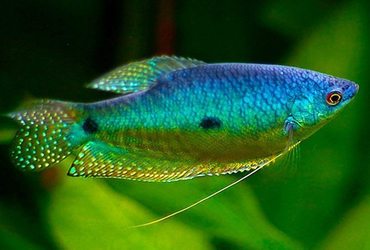- Saturday, 4th May, 2024

Lifestyle and nutrition of the three spot gourami
Trichopodus Trichopterus, otherwise called three spot gourami, is another mainstream freshwater gourami type. These fish are otherwise called blue gourami, gold gourami, and opaline gourami.
They start from the waterway in Myanmar, Cambodia, Thailand, Laos, Vietnam, Malaysia, Northern Indonesia, and Southern China. Presently, these fish have been acquainted with practically all nations on the planet.
They keep an eye on life in the sluggish swamp streams and vigorously vegetated including bogs, trenches, bogs, and lakes. A few populaces in the key to bring down the Mekong stream are known to relocate during the wet season into overwhelmed spots of woodlands or fields. And afterward getting back to the principle waterways when floodwaters start to subside.
As we probably are aware, T. Trichopterus are famous fish around the fish managers, and it ought not be difficult to come by these gourami species in the exchanges. They for the most part cost around $6 for sound single fish. You can discover them on the web, coming up, or with individual specialists.
Three Spot Gourami Appearance
There are 3 sorts of three spot gourami assortments that regularly appear to be in the exchanges. The principal assortment is “opal” or “opaline gourami” or “marbled gourami” or “Cosby gourami,” which has a brilliant blue base tone with some amazing profound cobalt blue splotches over their bodies and show extraordinary marbling impacts.
The subsequent assortment is blue gourami with a brilliant blue fundamental tone and smooth marbling with shades of lighter blue. Their tone can become further dependent on their states of mind and seasons of rearing. Another element of them is two dim spots. One is situated before the tail and the other in the focal point of the body. Albeit the normal name of them are three spot gourami, only two noticeable spots, and the third is really their eyes. Some of them might have some yellow bits here and on their blades.
The latter is “brilliant gourami” or “gold gourami,” a more dynamic hued assortment than the other. They have alluring gold-tone and more profound conditioned lined designing along the posterior. This gourami species don’t have the two dim spots on their body.
While the wild type of three spot gourami has a caramel shaded body with yellow on the gills, cover until the paunch, and set apart with unpredictable hazier stripped on the shoulder region. By specifically crossbreeding in hostage, these fish have another assortment: platinum and lavender (amethyst) varieties.
These gourami species have a similar profile as other gourami families; their bodies are level with huge adjusted blades. They have pectoral balances like needles and sweeping butt-centric balances.
Some of the time it’s very difficult to recognize guys and females. In any case, you can notice the females by their dorsal balances. They will in general have more limited adjusted dorsal blades. In examination, the guys’ dorsal balances are long and pointed. Furthermore, females appear to be somewhat more full when reproducing season.
Trichopodus Trichopterus can develop to reach up to 6 inches (15 cm), yet most aquarium examples will in general become more modest than this. Their normal life expectancy is around 4 – 6 years; they might live somewhat more in a decent living climate.
Three Spot Gourami Behavior And Temperaments
The three spot gourami have maze organs that permit these fish to assimilate the oxygen from the air. They will in general swim in the upper and center spaces of the aquarium. So you can see them swimming to the surface to set aside a breath from effort to time!
The three spotted gourami species are very quiet and can place tanks locally, however now and then you might see them in-battling with sets or gatherings. The guys at times become somewhat regional, particularly in more modest aquariums. Subsequent to rearing, guys will turn out to be more forceful to the females or different species around them.
They are so dynamic, and you can track down these exotic fish energetically swimming and investigating all regions in the aquarium. Now and then, they will nip at aquarium plants to eat some green growth. They will show you a fascinating show and never make you exhausted. As other little medium gourami fish species, they are very quiet and can be assembled with different species locally tank, in a little gathering, in pairs,s or solo.
You will be required no less than a 30-35-gallon size for minuscule grown-up gatherings or single fish. You can likewise utilize 20 gallons for adolescents, yet when they develop greater, you should move them to the bigger aquarium to oblige their solid swimming propensities and fun loving conduct. Assuming you need to keep them locally tank, suggested utilizing no less than a 50-gallon tank size or more to give serious swimming space. Plan your tank like their regular habitat, and it is the best condition to fulfill living in the aquariums. Picking dull shaded substrates, surface, and shading isn’t significant, and you can utilize rock or sand. For instance, you can utilize “Flourite Black Sand”. The dark tone from it can help pop their tinge and sparkle in the tank.
Three Spot Gourami Feeding And Diet
In the wild territory, three spotted gourami is really an omnivore. The Trichopodus Trichopterus nearly permits numerous more modest spineless creatures, green growth, zooplankton, and hatchlings. They might acknowledge any dry food varieties from the store in the aquarium, similar to fish pellets and green growth based chips.
Despite the fact that, you ought to enhance them with greater food too. It can upgrade their tinge, development, and wellbeing level. The three spot gourami fish will be appreciated when you give them live or frozen snacks, for example, tubifex worm, bloodworms, shrimp meats, saline solution shrimps, and other incredible decisions. They additionally acknowledge the vegetables like whitened lettuce.
Nutrition
T. trichopterus is omnivorous and primarily devours zooplankton (for example copepods, cladocerans, ostracods), macroinvertebrates (bug hatchlings) and incidentally rubbish and earthly macrophytes.


